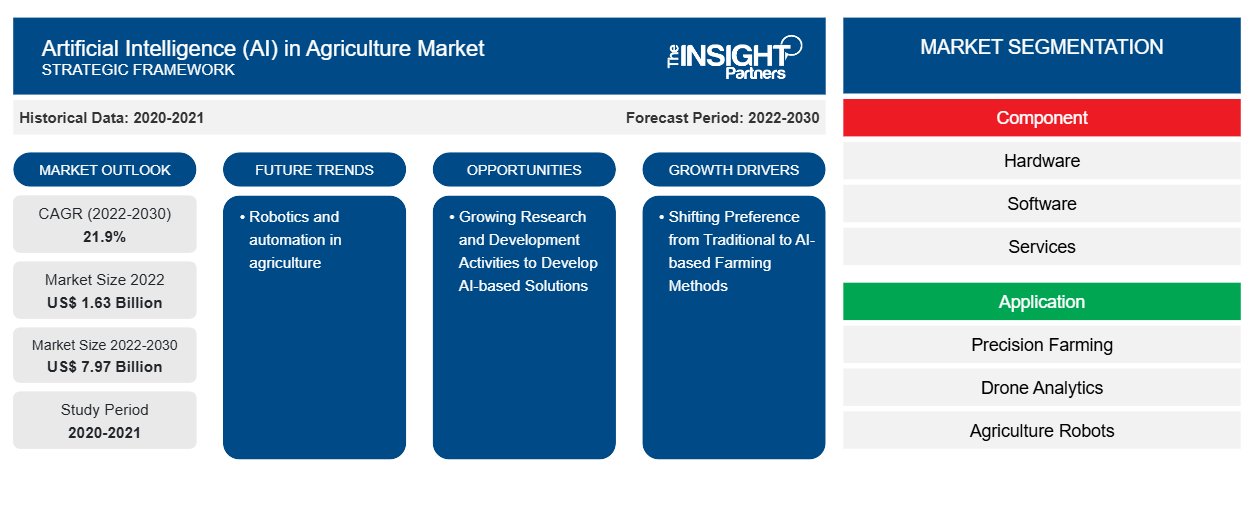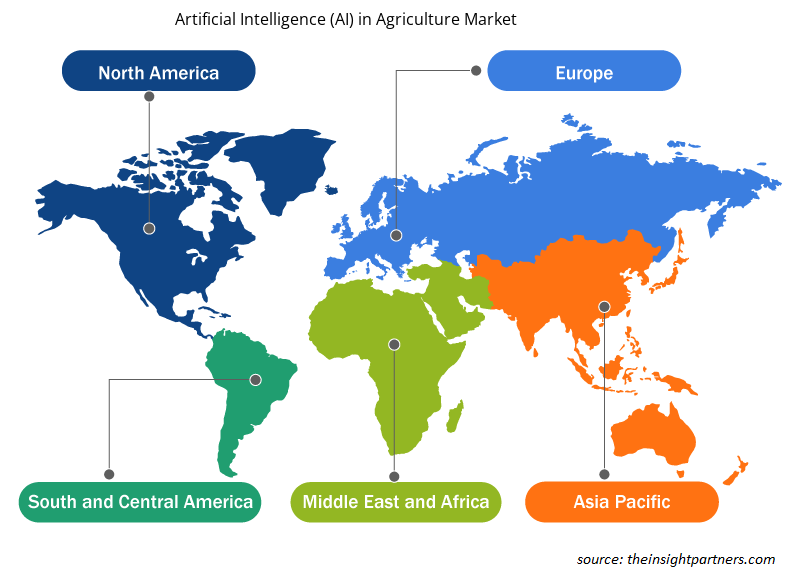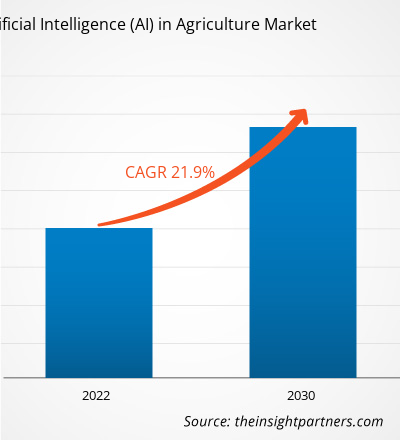Artificial intelligence (AI) in agriculture market size was valued at US$ 1.63 billion in 2022 and is expected to reach US$ 7.97 billion by 2030; it is estimated to record a CAGR of 21.9% from 2022 to 2030. Robotics and automation in agriculture are likely to remain key trends in the market.
Artificial Intelligence (AI) in Agriculture Market Analysis
Shifting preference from traditional to AI-based farming methods, growing use of unmanned ariel vehicles (UAVs) in farming, and increasing need for real-time analytics in agriculture are driving the market. The market is anticipated to grow during the forecast period, due to the growing government support for implementation of AI solutions. Moreover, growing research and development activities to develop AI-based solutions and increasing smart farming are creating lucrative opportunities for the market.
Artificial Intelligence (AI) in Agriculture Market Overview
Artificial intelligence (AI) is revolutionizing agriculture industry. Predictive analytics, computer vision, machine learning, and data analytics are helping agriculture overcome obstacles and realize its full potential. The use of Al in agriculture allows for data collection and analysis from a variety of sources, including soil conditions, weather patterns, crop health, and historical data.
Al-based systems can provide farmers with valuable information for increasing yields, reducing waste, and minimizing environmental concerns. Farmers and stakeholders can employ data-driven insights and intelligent decision-making to boost productivity, optimize resource use, and deal with agronomic issues. Smart machinery and robotics can be used to automate monotonous tasks in agriculture. These advances help farms address workforce shortages and focus on strategic planning and management.
Customize This Report To Suit Your Requirement
You will get customization on any report - free of charge - including parts of this report, or country-level analysis, Excel Data pack, as well as avail great offers and discounts for start-ups & universities
Artificial Intelligence (AI) in Agriculture Market: Strategic Insights

- Get Top Key Market Trends of this report.This FREE sample will include data analysis, ranging from market trends to estimates and forecasts.
You will get customization on any report - free of charge - including parts of this report, or country-level analysis, Excel Data pack, as well as avail great offers and discounts for start-ups & universities
Artificial Intelligence (AI) in Agriculture Market: Strategic Insights

- Get Top Key Market Trends of this report.This FREE sample will include data analysis, ranging from market trends to estimates and forecasts.
Artificial Intelligence (AI) in Agriculture Market Drivers and Opportunities
Shifting Preference from Traditional to AI-based Farming Methods
Traditional potato growers across Canada have faced challenges in nutrient management, a crucial aspect of farming that directly impacts crop yields. The conventional methods of soil treatments and foliar feeding, while effective to a certain extent, have limitations, especially for nutrients required at later stages of potato growth. Thus, potato growers across Canada are deploying AI solutions to predict the nutritional needs of the potato plant. For example, in November 2023, with groundbreaking developments in the agricultural sector, Canadian potato growers are turning to AI to monitor and predict the nutritional needs of their crops in real-time. Thus, the adoption of AI by Canadian farmers propels the growth of AI in agriculture market.
Growing Research and Development Activities to Develop AI-based Solutions
The UK boasts world-class technology and research capabilities and is the global leader in the development of AI-enabled solutions. Moreover, UK researchers are using AI to revolutionize traditional industries such as farming. As per January 2024 data, researchers at Harper Adams University are trying to make farming more sustainable and productive with AI.
The UK government has also announced US$ 39.82 million in funding to support the development of artificial intelligence projects across diverse sectors such as farming, fashion, and emergency services. An additional US$ 5.38 million has been awarded to feasibility studies for 100 projects from small businesses, fostering innovative AI ideas to boost productivity across various sectors. Thus, such government support is projected to propel the growth of AI in agriculture market.
Artificial Intelligence (AI) in Agriculture Market Report Segmentation Analysis
Key segments that contributed to the derivation of artificial intelligence (AI) in agriculture market analysis are components and applications.
- Based on component, artificial intelligence (AI) in agriculture market is divided into hardware, software, and services. The hardware segment held a larger market share in 2022.
- In terms of application, the market is divided into precision farming, drone analytics, agriculture robots, livestock monitoring, and others. The precision farming segment held a larger market share in 2022.
Artificial Intelligence (AI) in Agriculture Market Share Analysis by Geography
The geographic scope of the artificial intelligence (AI) in agriculture market report is mainly divided into five regions: North America, Asia Pacific, Europe, Middle East & Africa, and South & Central America.
The market in Asia Pacific is projected to expand during the forecast period, due to the growing demand for technologically advanced solutions. In countries such as Australia, where the agricultural workforce is quickly aging, the demand for skilled labor is greater than ever. Farming, with its integration of cutting-edge technology such as Al and machine learning, holds the key to closing this gap and bringing agriculture into the contemporary era. Several Australian farmers are already witnessing the benefits of Al-powered systems. For example, in October 2023, the Sunray Strawberries at Wamuran deployed the DeepBerry automated monitoring system; the system uses both visual and infrared imaging to accurately detect ripeness, bruising, fungus, fruit size, shape, and foreign objects. It can process more than 7,000 gunnets per hour. Implementation of such automated systems propels the growth of Al in agriculture market.
Artificial Intelligence (AI) in Agriculture Market Regional Insights
The regional trends and factors influencing the Artificial Intelligence (AI) in Agriculture Market throughout the forecast period have been thoroughly explained by the analysts at The Insight Partners. This section also discusses Artificial Intelligence (AI) in Agriculture Market segments and geography across North America, Europe, Asia Pacific, Middle East and Africa, and South and Central America.

- Get the Regional Specific Data for Artificial Intelligence (AI) in Agriculture Market
Artificial Intelligence (AI) in Agriculture Market Report Scope
| Report Attribute | Details |
|---|---|
| Market size in 2022 | US$ 1.63 Billion |
| Market Size by 2030 | US$ 7.97 Billion |
| Global CAGR (2022-2030) | 21.9% |
| Historical Data | 2020-2021 |
| Forecast period | 2022-2030 |
| Segments Covered |
By Component
|
| Regions and Countries Covered | North America
|
| Market leaders and key company profiles |
Artificial Intelligence (AI) in Agriculture Market Players Density: Understanding Its Impact on Business Dynamics
The Artificial Intelligence (AI) in Agriculture Market is growing rapidly, driven by increasing end-user demand due to factors such as evolving consumer preferences, technological advancements, and greater awareness of the product's benefits. As demand rises, businesses are expanding their offerings, innovating to meet consumer needs, and capitalizing on emerging trends, which further fuels market growth.
Market players density refers to the distribution of firms or companies operating within a particular market or industry. It indicates how many competitors (market players) are present in a given market space relative to its size or total market value.
Major Companies operating in the Artificial Intelligence (AI) in Agriculture Market are:
- Tule Technologies Inc
- PrecisionHawk Inc
- Easytosee Agtech SL
- Deere & Co
- Climate LLC
- Gamaya SA
Disclaimer: The companies listed above are not ranked in any particular order.

- Get the Artificial Intelligence (AI) in Agriculture Market top key players overview
Artificial Intelligence (AI) in Agriculture Market News and Recent Developments
The artificial intelligence (AI) in agriculture market is evaluated by gathering qualitative and quantitative data post primary and secondary research, which includes important corporate publications, association data, and databases. A few of the developments in the artificial intelligence (AI) in agriculture market are listed below:
- Chipotle Mexican Grill announced minority investments in Greenfield Robotics and Nitricity. The investment from Chipotle will help Greenfield Robotics expand its fleet and develop additional capabilities for its robots, such as micro-spraying, cover crop planting, and soil testing. (Source: Chipotle Mexican Grill, Company Website, December 2023).
Artificial Intelligence (AI) in Agriculture Market Report Coverage and Deliverables
The “Artificial Intelligence (AI) in Agriculture Market Size and Forecast (2020–2030)” report provides a detailed analysis of the market covering below areas:
- Artificial intelligence (AI) in agriculture market size and forecast at global, regional, and country levels for all the key market segments covered under the scope
- Artificial intelligence (AI) in agriculture market trends as well as market dynamics such as drivers, restraints, and key opportunities
- Detailed PEST/Porter’s Five Forces and SWOT analysis
- Artificial intelligence (AI) in agriculture market analysis covering key market trends, global and regional framework, major players, regulations, and recent market developments
- Industry landscape and competition analysis covering market concentration, heat map analysis, prominent players, and recent developments for the artificial intelligence (AI) in agriculture market
- Detailed company profiles
Frequently Asked Questions
What are the driving factors impacting the artificial intelligence (AI) in agriculture market?
Shifting preference from traditional to AI-based farming methods is the major factors that propel the global artificial intelligence (AI) in agriculture market.
Which region dominated the artificial intelligence (AI) in agriculture market in 2023?
North America dominated the artificial intelligence (AI) in agriculture market in 2023.
What is the expected CAGR of the artificial intelligence (AI) in agriculture market?
The global artificial intelligence (AI) in agriculture market is estimated to register a CAGR of 21.9% during the forecast period 2023–2031.
What would be the estimated value of the artificial intelligence (AI) in agriculture market by 2031?
The global artificial intelligence (AI) in agriculture market is expected to reach US$ 9.48 billion by 2031.
What are the future trends of the artificial intelligence (AI) in agriculture market?
Robotics and automation in agriculture to play a significant role in the global artificial intelligence (AI) in agriculture market in the coming years.
Which are the leading players operating in the artificial intelligence (AI) in agriculture market?
The key players holding majority shares in the global artificial intelligence (AI) in agriculture market are Tule Technologies Inc, PrecisionHawk Inc, Easytosee Agtech SL, Deere & Co, Climate LLC, Gamaya SA, International Business Machines Corp, Microsoft Corp, Prospera Technologies Ltd, and Taranis.
- Historical Analysis (2 Years), Base Year, Forecast (7 Years) with CAGR
- PEST and SWOT Analysis
- Market Size Value / Volume - Global, Regional, Country
- Industry and Competitive Landscape
- Excel Dataset
- Parking Meter Apps Market
- eSIM Market
- Advanced Distributed Management System Market
- Online Exam Proctoring Market
- Electronic Data Interchange Market
- Barcode Software Market
- Maritime Analytics Market
- Cloud Manufacturing Execution System (MES) Market
- Robotic Process Automation Market
- Digital Signature Market
Testimonials
Reason to Buy
- Informed Decision-Making
- Understanding Market Dynamics
- Competitive Analysis
- Identifying Emerging Markets
- Customer Insights
- Market Forecasts
- Risk Mitigation
- Boosting Operational Efficiency
- Strategic Planning
- Investment Justification
- Tracking Industry Innovations
- Aligning with Regulatory Trends
Yes! We provide a free sample of the report, which includes Report Scope (Table of Contents), report structure, and selected insights to help you assess the value of the full report. Please click on the "Download Sample" button or contact us to receive your copy.
Absolutely — analyst assistance is part of the package. You can connect with our analyst post-purchase to clarify report insights, methodology or discuss how the findings apply to your business needs.
Once your order is successfully placed, you will receive a confirmation email along with your invoice.
• For published reports: You’ll receive access to the report within 4–6 working hours via a secured email sent to your email.
• For upcoming reports: Your order will be recorded as a pre-booking. Our team will share the estimated release date and keep you informed of any updates. As soon as the report is published, it will be delivered to your registered email.
We offer customization options to align the report with your specific objectives. Whether you need deeper insights into a particular region, industry segment, competitor analysis, or data cut, our research team can tailor the report accordingly. Please share your requirements with us, and we’ll be happy to provide a customized proposal or scope.
The report is available in either PDF format or as an Excel dataset, depending on the license you choose.
The PDF version provides the full analysis and visuals in a ready-to-read format. The Excel dataset includes all underlying data tables for easy manipulation and further analysis.
Please review the license options at checkout or contact us to confirm which formats are included with your purchase.
Our payment process is fully secure and PCI-DSS compliant.
We use trusted and encrypted payment gateways to ensure that all transactions are protected with industry-standard SSL encryption. Your payment details are never stored on our servers and are handled securely by certified third-party processors.
You can make your purchase with confidence, knowing your personal and financial information is safe with us.
Yes, we do offer special pricing for bulk purchases.
If you're interested in purchasing multiple reports, we’re happy to provide a customized bundle offer or volume-based discount tailored to your needs. Please contact our sales team with the list of reports you’re considering, and we’ll share a personalized quote.
Yes, absolutely.
Our team is available to help you make an informed decision. Whether you have questions about the report’s scope, methodology, customization options, or which license suits you best, we’re here to assist. Please reach out to us at sales@theinsightpartners.com, and one of our representatives will get in touch promptly.
Yes, a billing invoice will be automatically generated and sent to your registered email upon successful completion of your purchase.
If you need the invoice in a specific format or require additional details (such as company name, GST, or VAT information), feel free to contact us, and we’ll be happy to assist.
Yes, certainly.
If you encounter any difficulties accessing or receiving your report, our support team is ready to assist you. Simply reach out to us via email or live chat with your order information, and we’ll ensure the issue is resolved quickly so you can access your report without interruption.





















 Get Free Sample For
Get Free Sample For